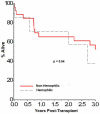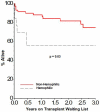Liver transplant outcomes in HIV+ haemophilic men
- PMID: 22762561
- PMCID: PMC4351753
- DOI: 10.1111/j.1365-2516.2012.02905.x
Liver transplant outcomes in HIV+ haemophilic men
Abstract
Hepatitis C virus infection is the major cause of end-stage liver disease and the major indication for transplantation (OLTX), including among HIV-HCV co-infected individuals. The age of HCV acquisition differs between haemophilic and non-haemophilic candidates, which may affect liver disease outcomes. The purpose of the study was to compare rates of pre- and post-OLTX mortality between co-infected haemophilic and non-haemophilic subjects without hepatocellular cancer participating in the Solid Organ Transplantation in HIV Study (HIV-TR). Clinical variables included age, gender, race, liver disease aetiology, BMI, antiretroviral therapy, MELD score, CD4 + cell count, HIV RNA PCR and HCV RNA PCR. Time to transplant, rejection and death were determined. Of 104 HIV-HCV positive subjects enrolled, 34 (32.7%) underwent liver transplantation, including 7 of 15 (46.7%) haemophilic and 27 of 89 (30.3%) non-haemophilic candidates. Although haemophilic subjects were younger, median 41 vs. 47 years, P = 0.01, they were more likely than non-haemophilic subjects to die pre-OLTX, 5 (33.3%) vs. 13 (14.6%), P = 0.03, and reached MELD = 25 marginally faster, 0.01 vs. 0.7 years, P = 0.06. The groups did not differ in baseline BMI, CD4, detectable HIV RNA, detectable HCV RNA, time to post-OLTX death (P = 0.64), graft loss (P = 0.80), or treated rejection (P = 0.77). The rate of rejection was 14% vs. 36% at 1-year and 36% vs. 43% at 3-year, haemophilic vs. non-haemophilic subjects, respectively, and post-OLTX survival, 71% vs. 66% at 1-year and 38% vs. 53% at 3-year. Despite similar transplant outcomes, pretransplant mortality is higher among co-infected haemophilic than non-haemophilic candidates.
Trial registration: ClinicalTrials.gov NCT00473629.
© 2012 Blackwell Publishing Ltd.
Figures






References
-
- Ragni MV, Belle SH. Impact of human immunodeficiency virus (HIV) on progression to end-stage liver disease in individuals with hemophilia and hepatitis C. J Infect Dis. 2001;183:1112–15. - PubMed
-
- Roland ME, Stock PG. Solid organ transplantation in HIV-infected recipients. Semin Liver Dis. 2006;26:273–84. - PubMed
-
- Pineda JA, Romero-Gomez M, Diaz-Garcia F, Giron-Gonzalez JA, Montero JL, Torre-Cisneros J, Andrade RJ, Gonzalez-Serrano M, Aguilar J, Aguilar-Guisado M, Navarro JM, Salmeron J, Caballero-Granado FJ, Francisco K. Garcia-Garcia JA, Grupo A. HIV co-infection shortens the survival of patients with hepatitis C virus-related decompensated cirrhosis. Hepatology. 2005;41:779–89. - PubMed
-
- Lin W, Weinberg EM, Tai AW, Peng LF, Brockman MA, Kim KA, Kim SS, Borges CB, Shao RX, Chung RT. HIV increases HCV replication in a TGF-beta1-dependent manner. Gastroenterology. 2008;134:803–11. - PubMed
-
- DeVera ME, Dvorchik I, Tom K, Eghtesad B, Shakil O, Demetris A, Jain A, Fung JJ, Ragni MV. Survival of liver transplant patients co-infected with HIV and HCV: the impact of recurrent hepatitis C. Am J Transplantation. 2006;6:2983–93. - PubMed

